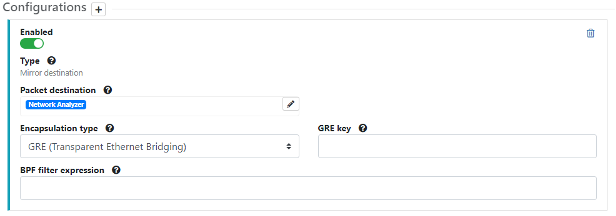The Mirror Destination Airwall Gateway receives the
mirrored traffic and sends it to your packet analyzer (or network analyzer or packet
broker).
If your packet analyzer supports receiving packets encapsulated in GRE or ERSPAN,
this is the preferred configuration. It avoids the possibly of mirrored traffic being
recirculated on your network and the MAC address table issues with switches. It also
provides additional fields to your packet analyzer that allow it to distinguish between
traffic captured by multiple Airwall Gateways (using GRE
key/ERSPAN session ID) and detect lost or reordered packets (using ERSPAN sequence
number).
-
On the Airwall Gateway
page, go to .
-
Select Edit Settings.
-
Next to Configurations, select the
+ to add a mirroring configuration.
-
In your new configuration:
-
Set the Enabled toggle to On.
Note: After configuration, use this toggle to turn mirroring on and
off.
-
Under Type, select Mirror
Destination.
-
Under Packet destination, select the local
device for your packet analyzer you set up earlier.
-
Under Encapsulation type, select the
encapsulation (GRE or ERSPAN Type I,
II, or III) supported by your packet analyzer. For
example, for Nozomi, pick ERSPAN type II. Refer to documentation of your
packet analyzer to determine which encapsulations it supports.
-
Optional – Enter any information allowed for the type you
selected (for example, GRE key or session ID).
-
Optional – Under BPF filter, add any BPF filters you
would like to use to filter the traffic that is mirrored to this Mirror
Destination. See BPF Settings for Port Mirroring.
Note: If you use a BPF expression on the Mirror Destination, that’s the
default for all of the Mirror Sources, unless you set a BPF
expression on the source, which overrides this default.
-
Select Update Settings.
You should be able to see some traffic from the Mirror Destination to the packet
analyzer local device.

